Country Analysis and Evaluation of India for Foreign Direct Investment (FDI)
VerifiedAdded on 2023/06/12
|16
|3727
|327
AI Summary
This report provides a country analysis and evaluation of India for Foreign Direct Investment (FDI). It covers India's political, economic, socio-cultural and technological influences and benefits for FDI. The report also discusses India's national resource and factor endowments that create competitive advantage, foreign currency and exchange influences, and the country's existing trade policies, systems, barriers and incentives. The subject is International Business Across Borders and the course code is not mentioned. Desklib is an online library for study material with solved assignments, essays, dissertations and more for students.
Contribute Materials
Your contribution can guide someone’s learning journey. Share your
documents today.
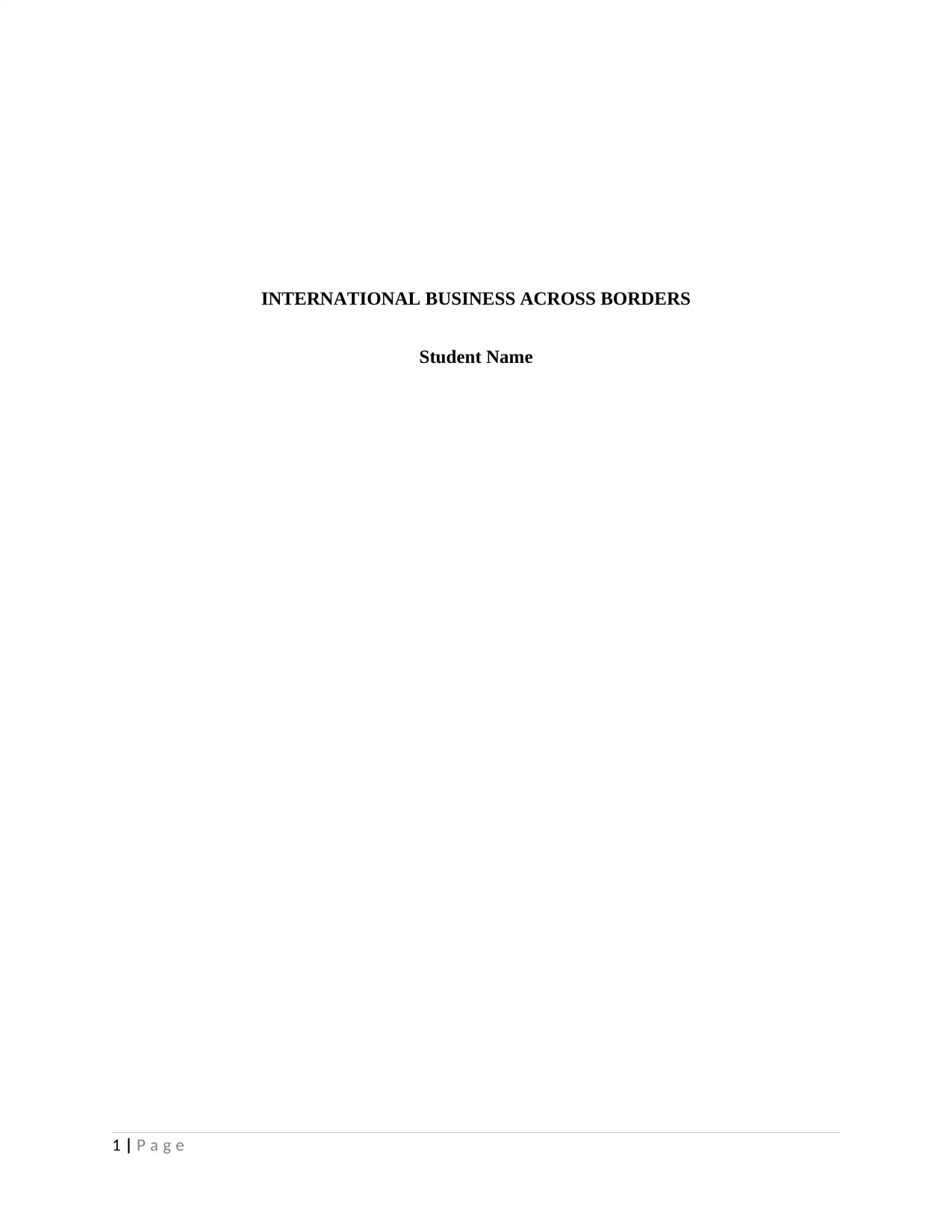
INTERNATIONAL BUSINESS ACROSS BORDERS
Student Name
1 | P a g e
Student Name
1 | P a g e
Secure Best Marks with AI Grader
Need help grading? Try our AI Grader for instant feedback on your assignments.

Table of Contents
Introduction......................................................................................................................................3
General overview of the country or region......................................................................................3
Political, Economic, Socio-cultural and Technological influences/ benefits/ advantages..............4
National resource and factor endowments that create competitive advantage..............................10
Foreign currency and exchange influences....................................................................................10
The countries existing trade policies, systems, barriers and incentives........................................11
Existing levels of FDI....................................................................................................................12
Summary and recommendations....................................................................................................13
References......................................................................................................................................14
2 | P a g e
Introduction......................................................................................................................................3
General overview of the country or region......................................................................................3
Political, Economic, Socio-cultural and Technological influences/ benefits/ advantages..............4
National resource and factor endowments that create competitive advantage..............................10
Foreign currency and exchange influences....................................................................................10
The countries existing trade policies, systems, barriers and incentives........................................11
Existing levels of FDI....................................................................................................................12
Summary and recommendations....................................................................................................13
References......................................................................................................................................14
2 | P a g e
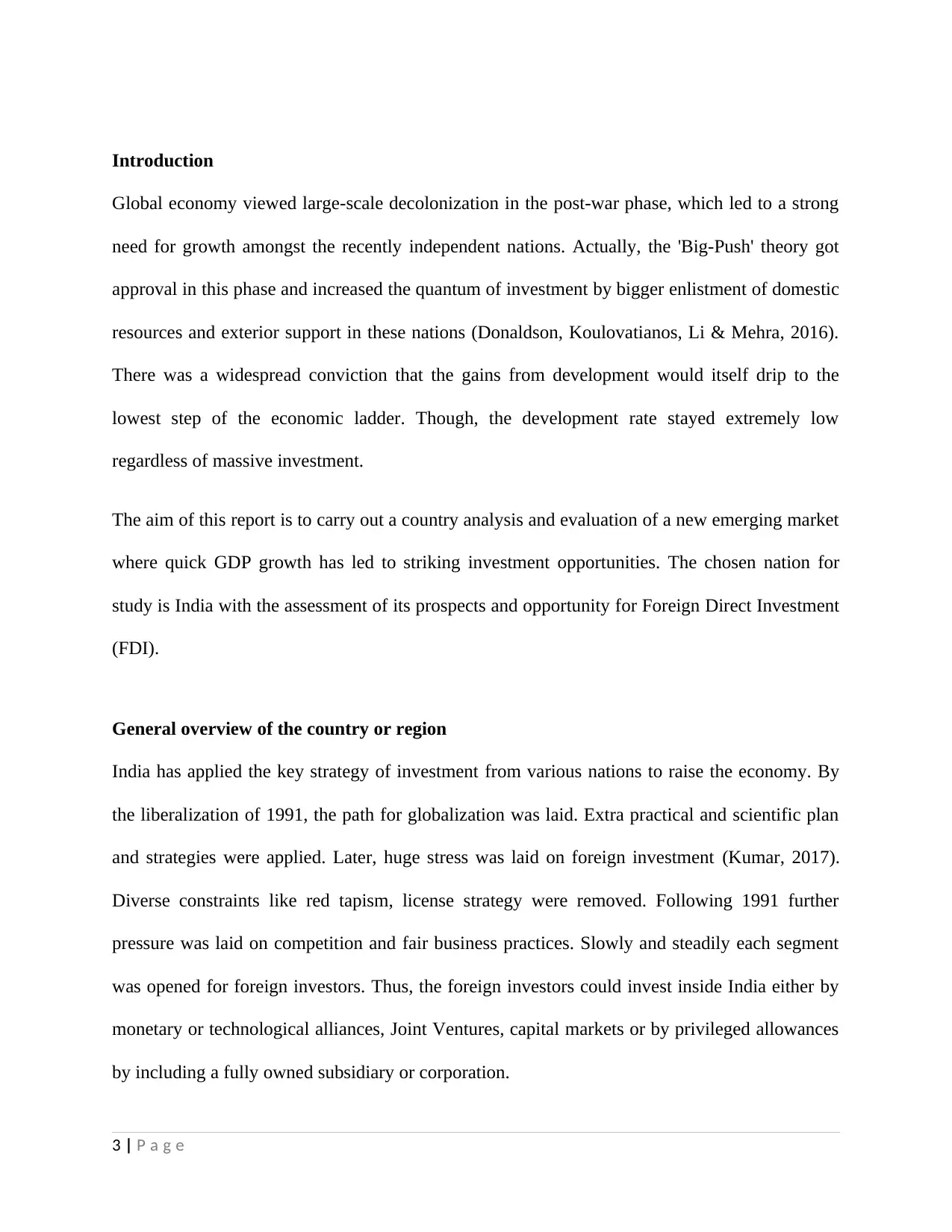
Introduction
Global economy viewed large-scale decolonization in the post-war phase, which led to a strong
need for growth amongst the recently independent nations. Actually, the 'Big-Push' theory got
approval in this phase and increased the quantum of investment by bigger enlistment of domestic
resources and exterior support in these nations (Donaldson, Koulovatianos, Li & Mehra, 2016).
There was a widespread conviction that the gains from development would itself drip to the
lowest step of the economic ladder. Though, the development rate stayed extremely low
regardless of massive investment.
The aim of this report is to carry out a country analysis and evaluation of a new emerging market
where quick GDP growth has led to striking investment opportunities. The chosen nation for
study is India with the assessment of its prospects and opportunity for Foreign Direct Investment
(FDI).
General overview of the country or region
India has applied the key strategy of investment from various nations to raise the economy. By
the liberalization of 1991, the path for globalization was laid. Extra practical and scientific plan
and strategies were applied. Later, huge stress was laid on foreign investment (Kumar, 2017).
Diverse constraints like red tapism, license strategy were removed. Following 1991 further
pressure was laid on competition and fair business practices. Slowly and steadily each segment
was opened for foreign investors. Thus, the foreign investors could invest inside India either by
monetary or technological alliances, Joint Ventures, capital markets or by privileged allowances
by including a fully owned subsidiary or corporation.
3 | P a g e
Global economy viewed large-scale decolonization in the post-war phase, which led to a strong
need for growth amongst the recently independent nations. Actually, the 'Big-Push' theory got
approval in this phase and increased the quantum of investment by bigger enlistment of domestic
resources and exterior support in these nations (Donaldson, Koulovatianos, Li & Mehra, 2016).
There was a widespread conviction that the gains from development would itself drip to the
lowest step of the economic ladder. Though, the development rate stayed extremely low
regardless of massive investment.
The aim of this report is to carry out a country analysis and evaluation of a new emerging market
where quick GDP growth has led to striking investment opportunities. The chosen nation for
study is India with the assessment of its prospects and opportunity for Foreign Direct Investment
(FDI).
General overview of the country or region
India has applied the key strategy of investment from various nations to raise the economy. By
the liberalization of 1991, the path for globalization was laid. Extra practical and scientific plan
and strategies were applied. Later, huge stress was laid on foreign investment (Kumar, 2017).
Diverse constraints like red tapism, license strategy were removed. Following 1991 further
pressure was laid on competition and fair business practices. Slowly and steadily each segment
was opened for foreign investors. Thus, the foreign investors could invest inside India either by
monetary or technological alliances, Joint Ventures, capital markets or by privileged allowances
by including a fully owned subsidiary or corporation.
3 | P a g e
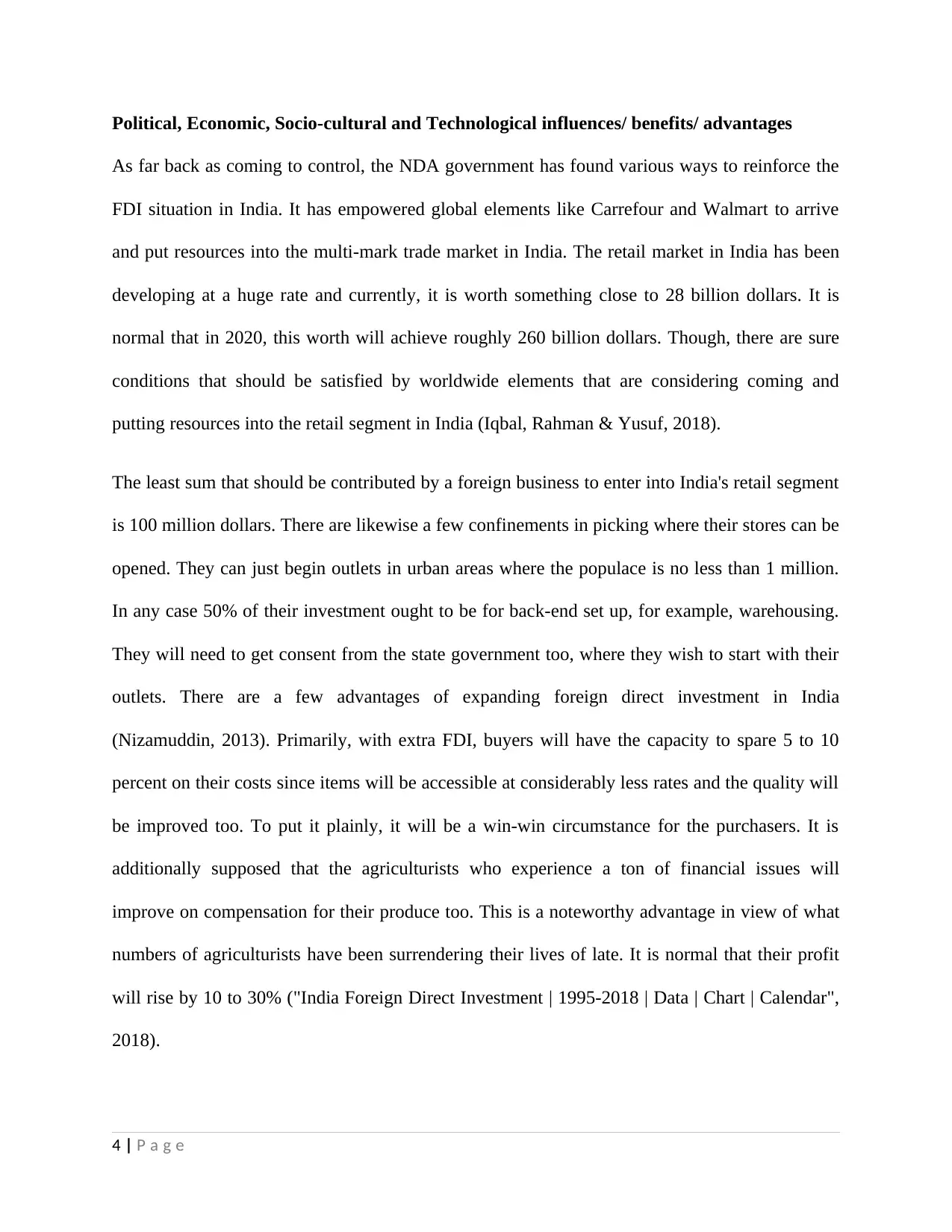
Political, Economic, Socio-cultural and Technological influences/ benefits/ advantages
As far back as coming to control, the NDA government has found various ways to reinforce the
FDI situation in India. It has empowered global elements like Carrefour and Walmart to arrive
and put resources into the multi-mark trade market in India. The retail market in India has been
developing at a huge rate and currently, it is worth something close to 28 billion dollars. It is
normal that in 2020, this worth will achieve roughly 260 billion dollars. Though, there are sure
conditions that should be satisfied by worldwide elements that are considering coming and
putting resources into the retail segment in India (Iqbal, Rahman & Yusuf, 2018).
The least sum that should be contributed by a foreign business to enter into India's retail segment
is 100 million dollars. There are likewise a few confinements in picking where their stores can be
opened. They can just begin outlets in urban areas where the populace is no less than 1 million.
In any case 50% of their investment ought to be for back-end set up, for example, warehousing.
They will need to get consent from the state government too, where they wish to start with their
outlets. There are a few advantages of expanding foreign direct investment in India
(Nizamuddin, 2013). Primarily, with extra FDI, buyers will have the capacity to spare 5 to 10
percent on their costs since items will be accessible at considerably less rates and the quality will
be improved too. To put it plainly, it will be a win-win circumstance for the purchasers. It is
additionally supposed that the agriculturists who experience a ton of financial issues will
improve on compensation for their produce too. This is a noteworthy advantage in view of what
numbers of agriculturists have been surrendering their lives of late. It is normal that their profit
will rise by 10 to 30% ("India Foreign Direct Investment | 1995-2018 | Data | Chart | Calendar",
2018).
4 | P a g e
As far back as coming to control, the NDA government has found various ways to reinforce the
FDI situation in India. It has empowered global elements like Carrefour and Walmart to arrive
and put resources into the multi-mark trade market in India. The retail market in India has been
developing at a huge rate and currently, it is worth something close to 28 billion dollars. It is
normal that in 2020, this worth will achieve roughly 260 billion dollars. Though, there are sure
conditions that should be satisfied by worldwide elements that are considering coming and
putting resources into the retail segment in India (Iqbal, Rahman & Yusuf, 2018).
The least sum that should be contributed by a foreign business to enter into India's retail segment
is 100 million dollars. There are likewise a few confinements in picking where their stores can be
opened. They can just begin outlets in urban areas where the populace is no less than 1 million.
In any case 50% of their investment ought to be for back-end set up, for example, warehousing.
They will need to get consent from the state government too, where they wish to start with their
outlets. There are a few advantages of expanding foreign direct investment in India
(Nizamuddin, 2013). Primarily, with extra FDI, buyers will have the capacity to spare 5 to 10
percent on their costs since items will be accessible at considerably less rates and the quality will
be improved too. To put it plainly, it will be a win-win circumstance for the purchasers. It is
additionally supposed that the agriculturists who experience a ton of financial issues will
improve on compensation for their produce too. This is a noteworthy advantage in view of what
numbers of agriculturists have been surrendering their lives of late. It is normal that their profit
will rise by 10 to 30% ("India Foreign Direct Investment | 1995-2018 | Data | Chart | Calendar",
2018).
4 | P a g e
Secure Best Marks with AI Grader
Need help grading? Try our AI Grader for instant feedback on your assignments.
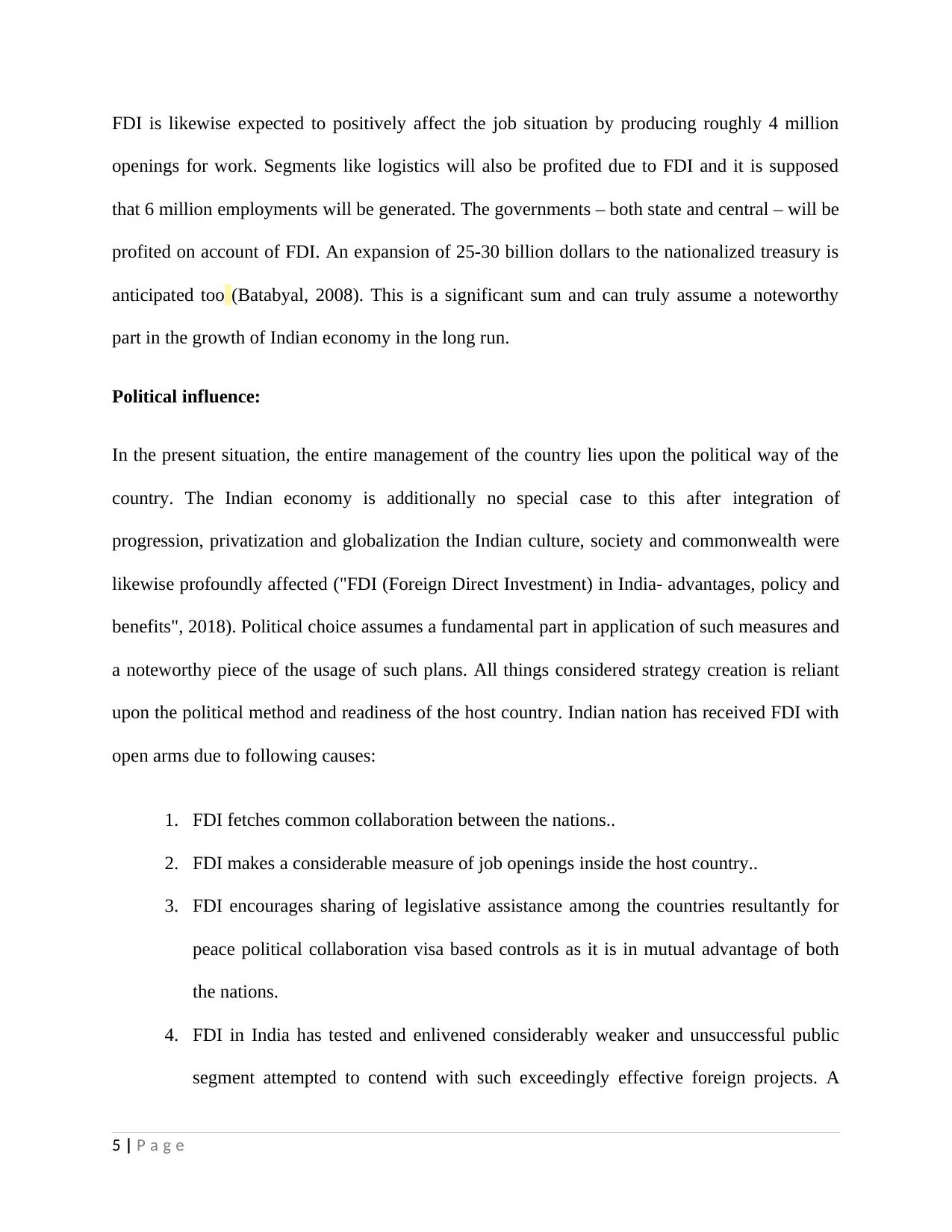
FDI is likewise expected to positively affect the job situation by producing roughly 4 million
openings for work. Segments like logistics will also be profited due to FDI and it is supposed
that 6 million employments will be generated. The governments – both state and central – will be
profited on account of FDI. An expansion of 25-30 billion dollars to the nationalized treasury is
anticipated too (Batabyal, 2008). This is a significant sum and can truly assume a noteworthy
part in the growth of Indian economy in the long run.
Political influence:
In the present situation, the entire management of the country lies upon the political way of the
country. The Indian economy is additionally no special case to this after integration of
progression, privatization and globalization the Indian culture, society and commonwealth were
likewise profoundly affected ("FDI (Foreign Direct Investment) in India- advantages, policy and
benefits", 2018). Political choice assumes a fundamental part in application of such measures and
a noteworthy piece of the usage of such plans. All things considered strategy creation is reliant
upon the political method and readiness of the host country. Indian nation has received FDI with
open arms due to following causes:
1. FDI fetches common collaboration between the nations..
2. FDI makes a considerable measure of job openings inside the host country..
3. FDI encourages sharing of legislative assistance among the countries resultantly for
peace political collaboration visa based controls as it is in mutual advantage of both
the nations.
4. FDI in India has tested and enlivened considerably weaker and unsuccessful public
segment attempted to contend with such exceedingly effective foreign projects. A
5 | P a g e
openings for work. Segments like logistics will also be profited due to FDI and it is supposed
that 6 million employments will be generated. The governments – both state and central – will be
profited on account of FDI. An expansion of 25-30 billion dollars to the nationalized treasury is
anticipated too (Batabyal, 2008). This is a significant sum and can truly assume a noteworthy
part in the growth of Indian economy in the long run.
Political influence:
In the present situation, the entire management of the country lies upon the political way of the
country. The Indian economy is additionally no special case to this after integration of
progression, privatization and globalization the Indian culture, society and commonwealth were
likewise profoundly affected ("FDI (Foreign Direct Investment) in India- advantages, policy and
benefits", 2018). Political choice assumes a fundamental part in application of such measures and
a noteworthy piece of the usage of such plans. All things considered strategy creation is reliant
upon the political method and readiness of the host country. Indian nation has received FDI with
open arms due to following causes:
1. FDI fetches common collaboration between the nations..
2. FDI makes a considerable measure of job openings inside the host country..
3. FDI encourages sharing of legislative assistance among the countries resultantly for
peace political collaboration visa based controls as it is in mutual advantage of both
the nations.
4. FDI in India has tested and enlivened considerably weaker and unsuccessful public
segment attempted to contend with such exceedingly effective foreign projects. A
5 | P a g e
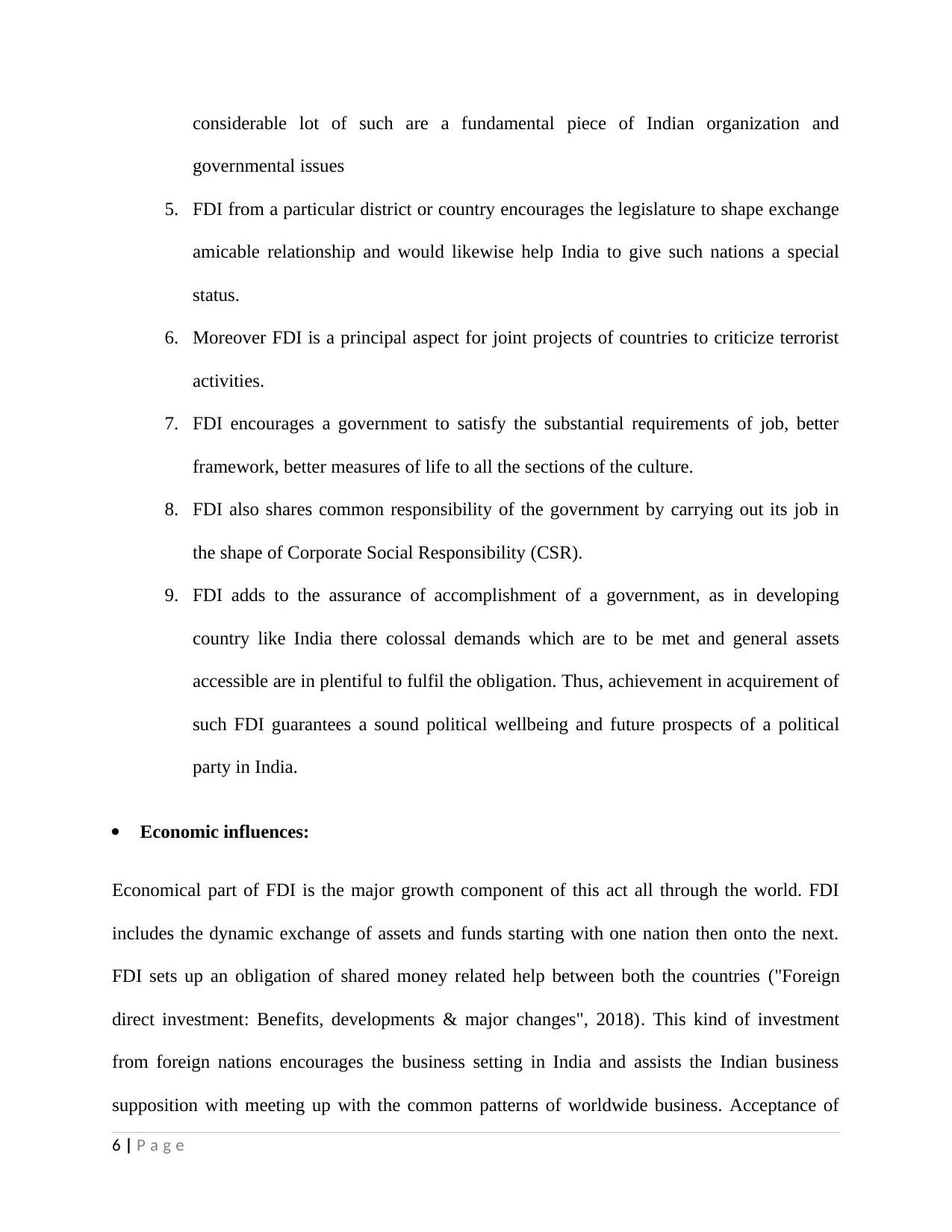
considerable lot of such are a fundamental piece of Indian organization and
governmental issues
5. FDI from a particular district or country encourages the legislature to shape exchange
amicable relationship and would likewise help India to give such nations a special
status.
6. Moreover FDI is a principal aspect for joint projects of countries to criticize terrorist
activities.
7. FDI encourages a government to satisfy the substantial requirements of job, better
framework, better measures of life to all the sections of the culture.
8. FDI also shares common responsibility of the government by carrying out its job in
the shape of Corporate Social Responsibility (CSR).
9. FDI adds to the assurance of accomplishment of a government, as in developing
country like India there colossal demands which are to be met and general assets
accessible are in plentiful to fulfil the obligation. Thus, achievement in acquirement of
such FDI guarantees a sound political wellbeing and future prospects of a political
party in India.
Economic influences:
Economical part of FDI is the major growth component of this act all through the world. FDI
includes the dynamic exchange of assets and funds starting with one nation then onto the next.
FDI sets up an obligation of shared money related help between both the countries ("Foreign
direct investment: Benefits, developments & major changes", 2018). This kind of investment
from foreign nations encourages the business setting in India and assists the Indian business
supposition with meeting up with the common patterns of worldwide business. Acceptance of
6 | P a g e
governmental issues
5. FDI from a particular district or country encourages the legislature to shape exchange
amicable relationship and would likewise help India to give such nations a special
status.
6. Moreover FDI is a principal aspect for joint projects of countries to criticize terrorist
activities.
7. FDI encourages a government to satisfy the substantial requirements of job, better
framework, better measures of life to all the sections of the culture.
8. FDI also shares common responsibility of the government by carrying out its job in
the shape of Corporate Social Responsibility (CSR).
9. FDI adds to the assurance of accomplishment of a government, as in developing
country like India there colossal demands which are to be met and general assets
accessible are in plentiful to fulfil the obligation. Thus, achievement in acquirement of
such FDI guarantees a sound political wellbeing and future prospects of a political
party in India.
Economic influences:
Economical part of FDI is the major growth component of this act all through the world. FDI
includes the dynamic exchange of assets and funds starting with one nation then onto the next.
FDI sets up an obligation of shared money related help between both the countries ("Foreign
direct investment: Benefits, developments & major changes", 2018). This kind of investment
from foreign nations encourages the business setting in India and assists the Indian business
supposition with meeting up with the common patterns of worldwide business. Acceptance of
6 | P a g e
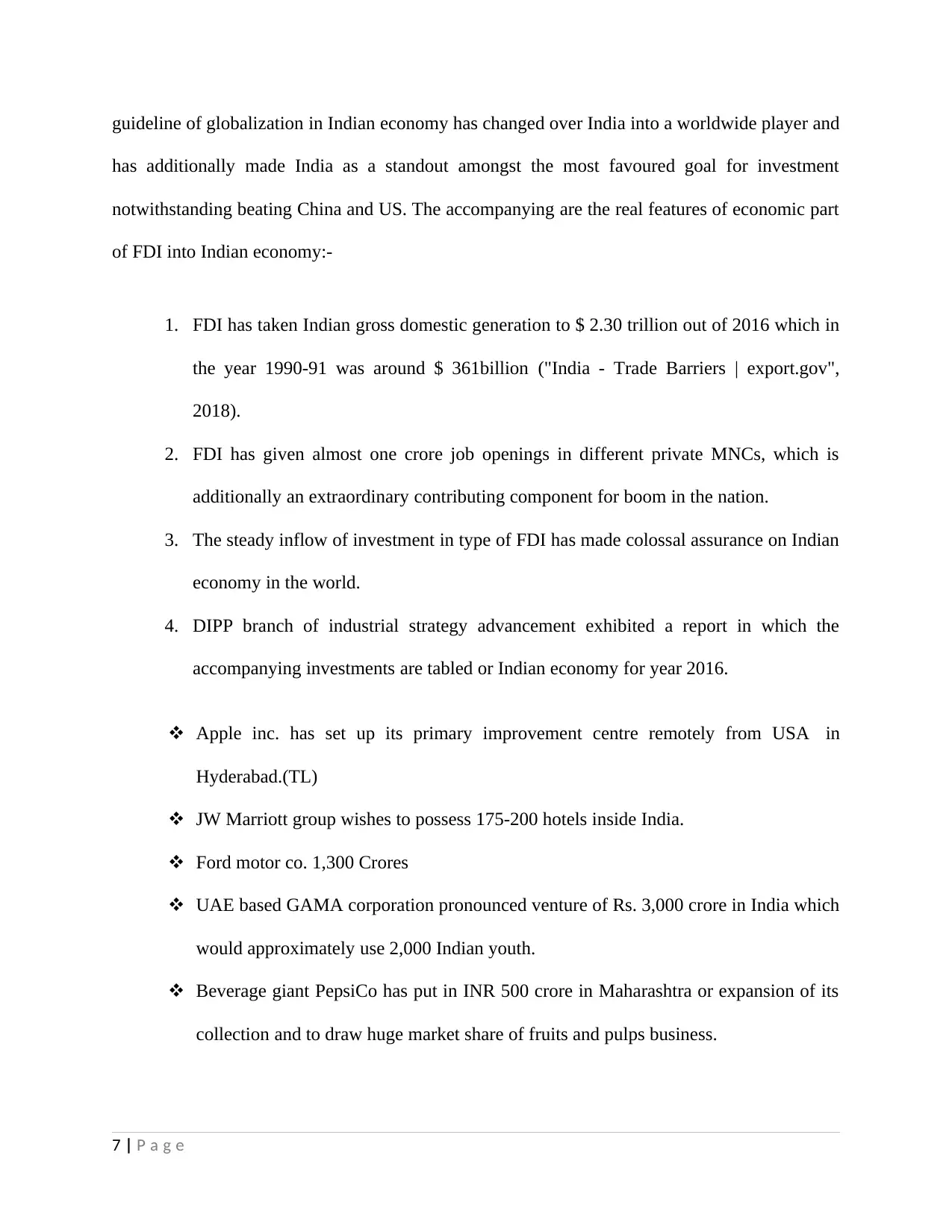
guideline of globalization in Indian economy has changed over India into a worldwide player and
has additionally made India as a standout amongst the most favoured goal for investment
notwithstanding beating China and US. The accompanying are the real features of economic part
of FDI into Indian economy:-
1. FDI has taken Indian gross domestic generation to $ 2.30 trillion out of 2016 which in
the year 1990-91 was around $ 361billion ("India - Trade Barriers | export.gov",
2018).
2. FDI has given almost one crore job openings in different private MNCs, which is
additionally an extraordinary contributing component for boom in the nation.
3. The steady inflow of investment in type of FDI has made colossal assurance on Indian
economy in the world.
4. DIPP branch of industrial strategy advancement exhibited a report in which the
accompanying investments are tabled or Indian economy for year 2016.
Apple inc. has set up its primary improvement centre remotely from USA in
Hyderabad.(TL)
JW Marriott group wishes to possess 175-200 hotels inside India.
Ford motor co. 1,300 Crores
UAE based GAMA corporation pronounced venture of Rs. 3,000 crore in India which
would approximately use 2,000 Indian youth.
Beverage giant PepsiCo has put in INR 500 crore in Maharashtra or expansion of its
collection and to draw huge market share of fruits and pulps business.
7 | P a g e
has additionally made India as a standout amongst the most favoured goal for investment
notwithstanding beating China and US. The accompanying are the real features of economic part
of FDI into Indian economy:-
1. FDI has taken Indian gross domestic generation to $ 2.30 trillion out of 2016 which in
the year 1990-91 was around $ 361billion ("India - Trade Barriers | export.gov",
2018).
2. FDI has given almost one crore job openings in different private MNCs, which is
additionally an extraordinary contributing component for boom in the nation.
3. The steady inflow of investment in type of FDI has made colossal assurance on Indian
economy in the world.
4. DIPP branch of industrial strategy advancement exhibited a report in which the
accompanying investments are tabled or Indian economy for year 2016.
Apple inc. has set up its primary improvement centre remotely from USA in
Hyderabad.(TL)
JW Marriott group wishes to possess 175-200 hotels inside India.
Ford motor co. 1,300 Crores
UAE based GAMA corporation pronounced venture of Rs. 3,000 crore in India which
would approximately use 2,000 Indian youth.
Beverage giant PepsiCo has put in INR 500 crore in Maharashtra or expansion of its
collection and to draw huge market share of fruits and pulps business.
7 | P a g e
Paraphrase This Document
Need a fresh take? Get an instant paraphrase of this document with our AI Paraphraser
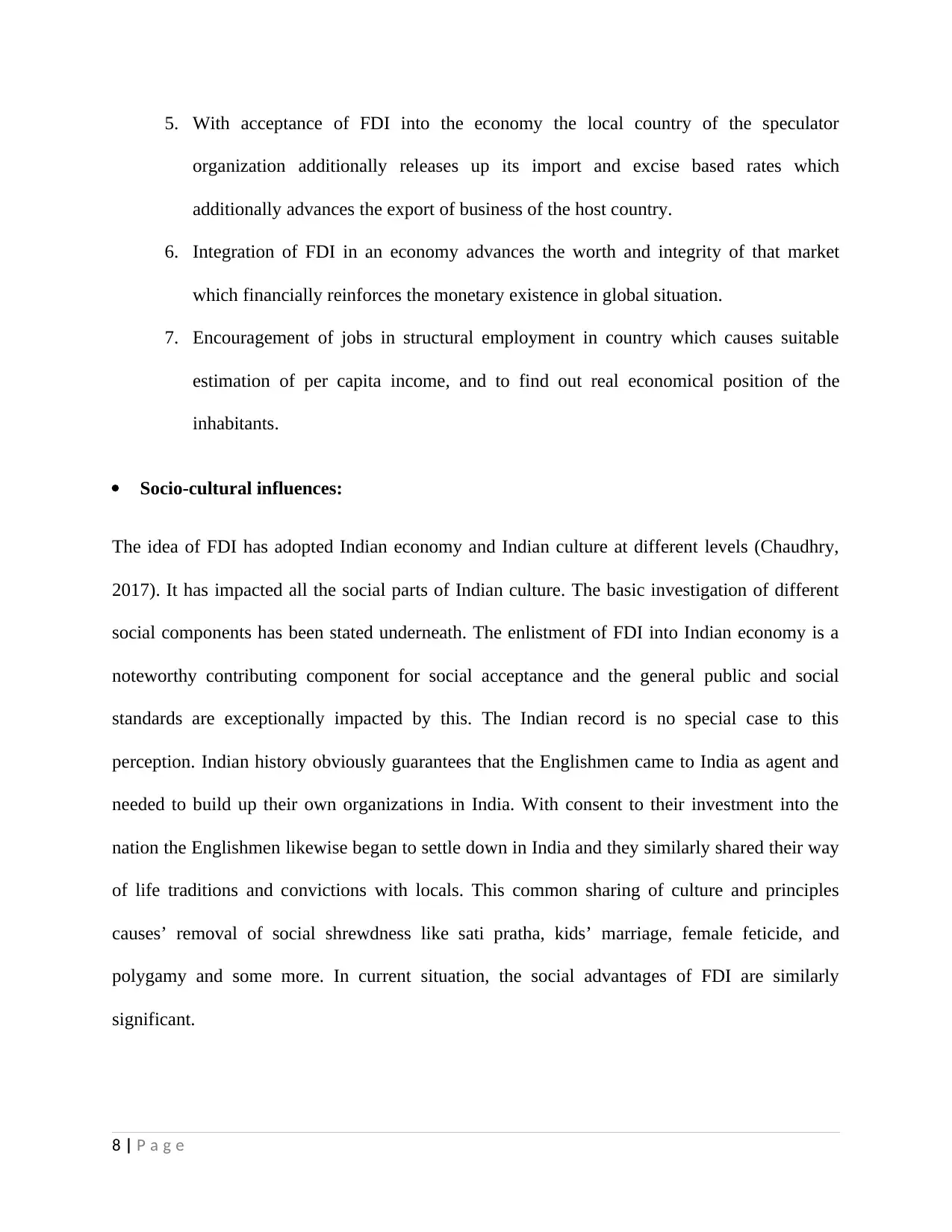
5. With acceptance of FDI into the economy the local country of the speculator
organization additionally releases up its import and excise based rates which
additionally advances the export of business of the host country.
6. Integration of FDI in an economy advances the worth and integrity of that market
which financially reinforces the monetary existence in global situation.
7. Encouragement of jobs in structural employment in country which causes suitable
estimation of per capita income, and to find out real economical position of the
inhabitants.
Socio-cultural influences:
The idea of FDI has adopted Indian economy and Indian culture at different levels (Chaudhry,
2017). It has impacted all the social parts of Indian culture. The basic investigation of different
social components has been stated underneath. The enlistment of FDI into Indian economy is a
noteworthy contributing component for social acceptance and the general public and social
standards are exceptionally impacted by this. The Indian record is no special case to this
perception. Indian history obviously guarantees that the Englishmen came to India as agent and
needed to build up their own organizations in India. With consent to their investment into the
nation the Englishmen likewise began to settle down in India and they similarly shared their way
of life traditions and convictions with locals. This common sharing of culture and principles
causes’ removal of social shrewdness like sati pratha, kids’ marriage, female feticide, and
polygamy and some more. In current situation, the social advantages of FDI are similarly
significant.
8 | P a g e
organization additionally releases up its import and excise based rates which
additionally advances the export of business of the host country.
6. Integration of FDI in an economy advances the worth and integrity of that market
which financially reinforces the monetary existence in global situation.
7. Encouragement of jobs in structural employment in country which causes suitable
estimation of per capita income, and to find out real economical position of the
inhabitants.
Socio-cultural influences:
The idea of FDI has adopted Indian economy and Indian culture at different levels (Chaudhry,
2017). It has impacted all the social parts of Indian culture. The basic investigation of different
social components has been stated underneath. The enlistment of FDI into Indian economy is a
noteworthy contributing component for social acceptance and the general public and social
standards are exceptionally impacted by this. The Indian record is no special case to this
perception. Indian history obviously guarantees that the Englishmen came to India as agent and
needed to build up their own organizations in India. With consent to their investment into the
nation the Englishmen likewise began to settle down in India and they similarly shared their way
of life traditions and convictions with locals. This common sharing of culture and principles
causes’ removal of social shrewdness like sati pratha, kids’ marriage, female feticide, and
polygamy and some more. In current situation, the social advantages of FDI are similarly
significant.
8 | P a g e
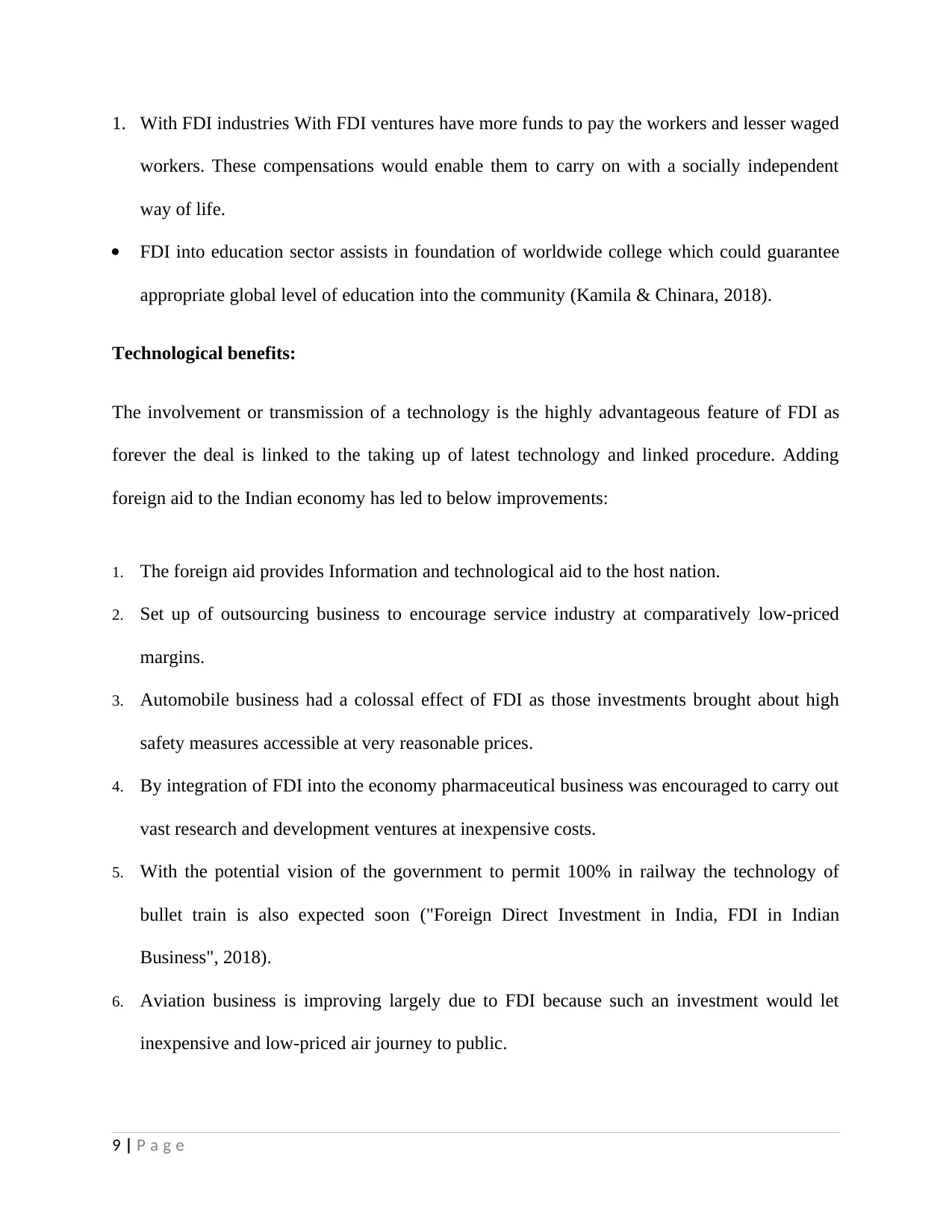
1. With FDI industries With FDI ventures have more funds to pay the workers and lesser waged
workers. These compensations would enable them to carry on with a socially independent
way of life.
FDI into education sector assists in foundation of worldwide college which could guarantee
appropriate global level of education into the community (Kamila & Chinara, 2018).
Technological benefits:
The involvement or transmission of a technology is the highly advantageous feature of FDI as
forever the deal is linked to the taking up of latest technology and linked procedure. Adding
foreign aid to the Indian economy has led to below improvements:
1. The foreign aid provides Information and technological aid to the host nation.
2. Set up of outsourcing business to encourage service industry at comparatively low-priced
margins.
3. Automobile business had a colossal effect of FDI as those investments brought about high
safety measures accessible at very reasonable prices.
4. By integration of FDI into the economy pharmaceutical business was encouraged to carry out
vast research and development ventures at inexpensive costs.
5. With the potential vision of the government to permit 100% in railway the technology of
bullet train is also expected soon ("Foreign Direct Investment in India, FDI in Indian
Business", 2018).
6. Aviation business is improving largely due to FDI because such an investment would let
inexpensive and low-priced air journey to public.
9 | P a g e
workers. These compensations would enable them to carry on with a socially independent
way of life.
FDI into education sector assists in foundation of worldwide college which could guarantee
appropriate global level of education into the community (Kamila & Chinara, 2018).
Technological benefits:
The involvement or transmission of a technology is the highly advantageous feature of FDI as
forever the deal is linked to the taking up of latest technology and linked procedure. Adding
foreign aid to the Indian economy has led to below improvements:
1. The foreign aid provides Information and technological aid to the host nation.
2. Set up of outsourcing business to encourage service industry at comparatively low-priced
margins.
3. Automobile business had a colossal effect of FDI as those investments brought about high
safety measures accessible at very reasonable prices.
4. By integration of FDI into the economy pharmaceutical business was encouraged to carry out
vast research and development ventures at inexpensive costs.
5. With the potential vision of the government to permit 100% in railway the technology of
bullet train is also expected soon ("Foreign Direct Investment in India, FDI in Indian
Business", 2018).
6. Aviation business is improving largely due to FDI because such an investment would let
inexpensive and low-priced air journey to public.
9 | P a g e
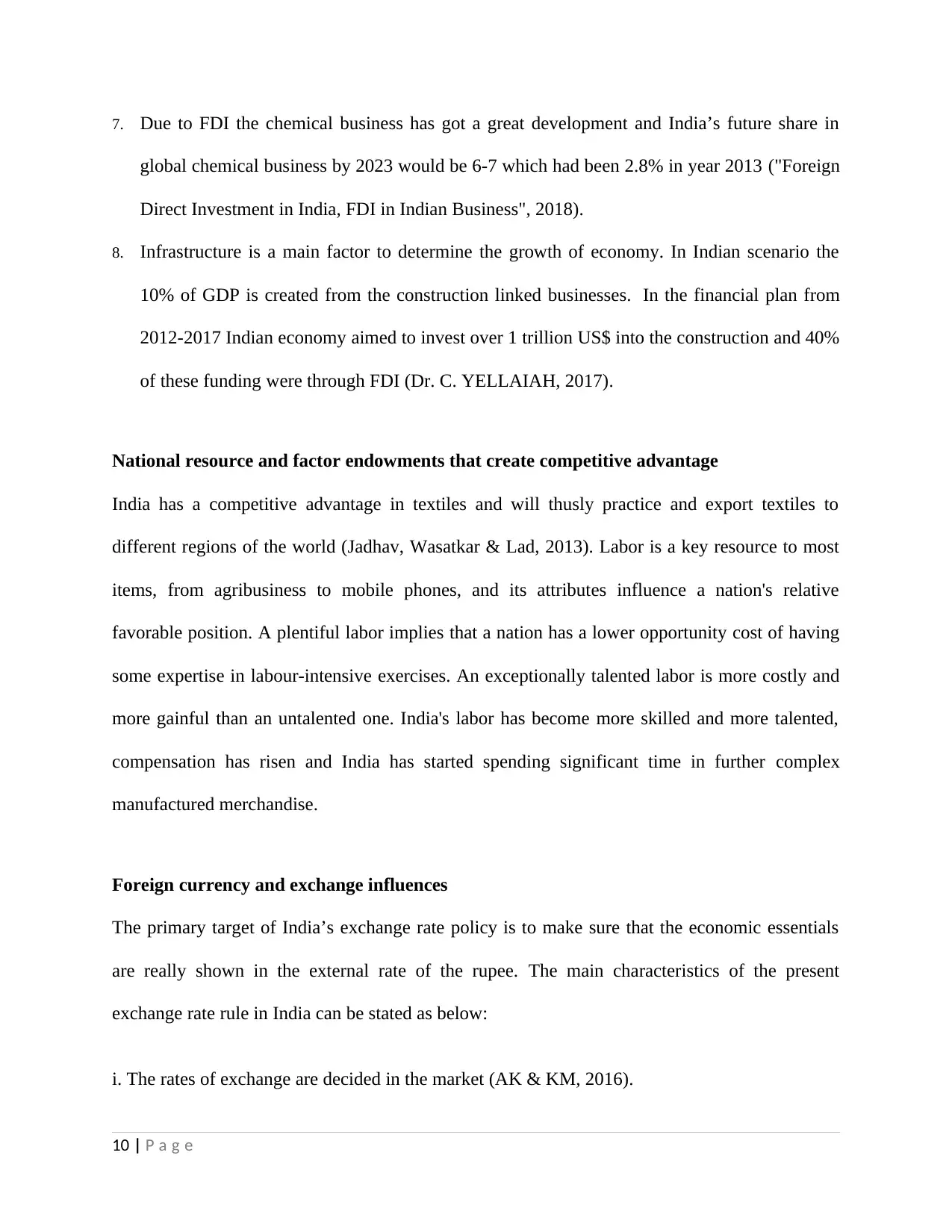
7. Due to FDI the chemical business has got a great development and India’s future share in
global chemical business by 2023 would be 6-7 which had been 2.8% in year 2013 ("Foreign
Direct Investment in India, FDI in Indian Business", 2018).
8. Infrastructure is a main factor to determine the growth of economy. In Indian scenario the
10% of GDP is created from the construction linked businesses. In the financial plan from
2012-2017 Indian economy aimed to invest over 1 trillion US$ into the construction and 40%
of these funding were through FDI (Dr. C. YELLAIAH, 2017).
National resource and factor endowments that create competitive advantage
India has a competitive advantage in textiles and will thusly practice and export textiles to
different regions of the world (Jadhav, Wasatkar & Lad, 2013). Labor is a key resource to most
items, from agribusiness to mobile phones, and its attributes influence a nation's relative
favorable position. A plentiful labor implies that a nation has a lower opportunity cost of having
some expertise in labour-intensive exercises. An exceptionally talented labor is more costly and
more gainful than an untalented one. India's labor has become more skilled and more talented,
compensation has risen and India has started spending significant time in further complex
manufactured merchandise.
Foreign currency and exchange influences
The primary target of India’s exchange rate policy is to make sure that the economic essentials
are really shown in the external rate of the rupee. The main characteristics of the present
exchange rate rule in India can be stated as below:
i. The rates of exchange are decided in the market (AK & KM, 2016).
10 | P a g e
global chemical business by 2023 would be 6-7 which had been 2.8% in year 2013 ("Foreign
Direct Investment in India, FDI in Indian Business", 2018).
8. Infrastructure is a main factor to determine the growth of economy. In Indian scenario the
10% of GDP is created from the construction linked businesses. In the financial plan from
2012-2017 Indian economy aimed to invest over 1 trillion US$ into the construction and 40%
of these funding were through FDI (Dr. C. YELLAIAH, 2017).
National resource and factor endowments that create competitive advantage
India has a competitive advantage in textiles and will thusly practice and export textiles to
different regions of the world (Jadhav, Wasatkar & Lad, 2013). Labor is a key resource to most
items, from agribusiness to mobile phones, and its attributes influence a nation's relative
favorable position. A plentiful labor implies that a nation has a lower opportunity cost of having
some expertise in labour-intensive exercises. An exceptionally talented labor is more costly and
more gainful than an untalented one. India's labor has become more skilled and more talented,
compensation has risen and India has started spending significant time in further complex
manufactured merchandise.
Foreign currency and exchange influences
The primary target of India’s exchange rate policy is to make sure that the economic essentials
are really shown in the external rate of the rupee. The main characteristics of the present
exchange rate rule in India can be stated as below:
i. The rates of exchange are decided in the market (AK & KM, 2016).
10 | P a g e
Secure Best Marks with AI Grader
Need help grading? Try our AI Grader for instant feedback on your assignments.
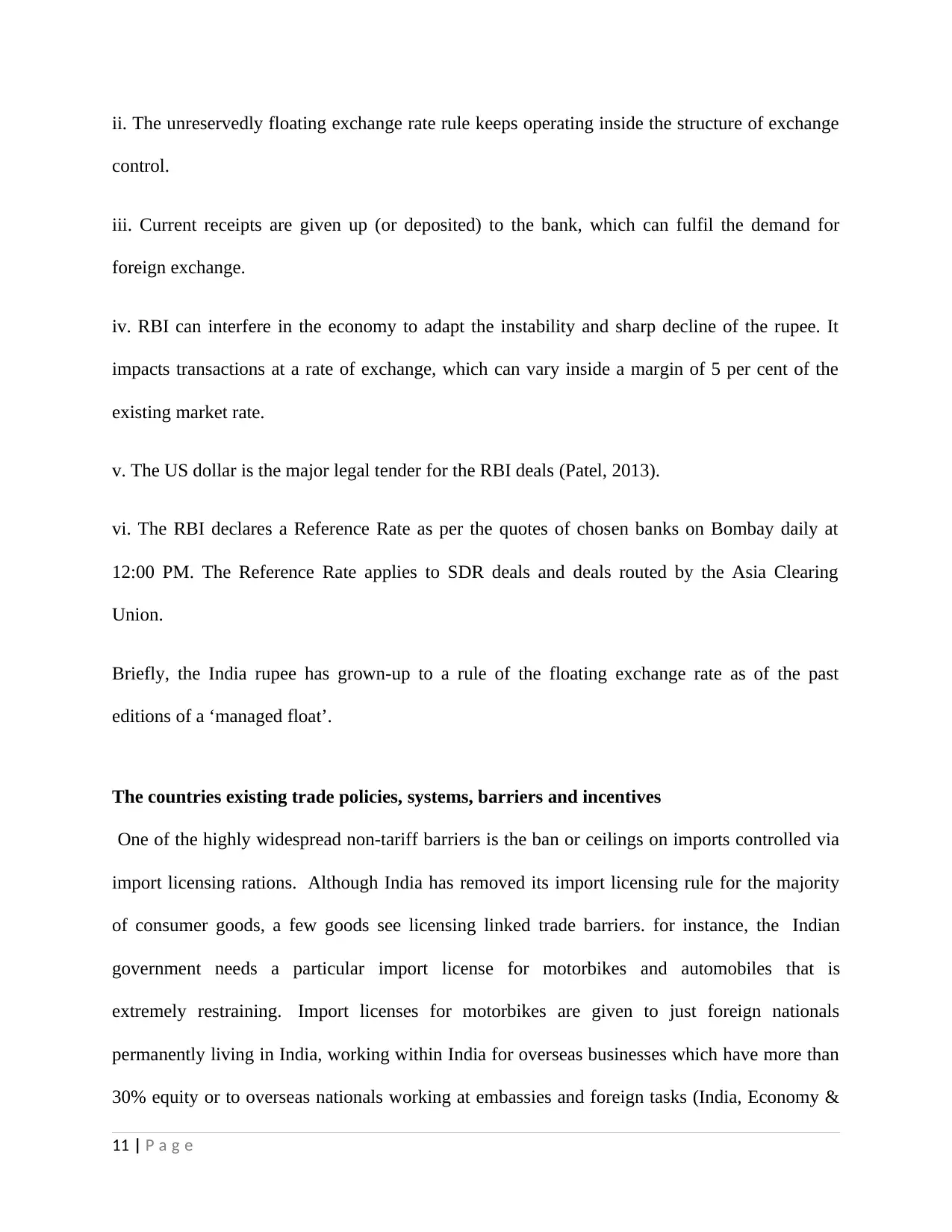
ii. The unreservedly floating exchange rate rule keeps operating inside the structure of exchange
control.
iii. Current receipts are given up (or deposited) to the bank, which can fulfil the demand for
foreign exchange.
iv. RBI can interfere in the economy to adapt the instability and sharp decline of the rupee. It
impacts transactions at a rate of exchange, which can vary inside a margin of 5 per cent of the
existing market rate.
v. The US dollar is the major legal tender for the RBI deals (Patel, 2013).
vi. The RBI declares a Reference Rate as per the quotes of chosen banks on Bombay daily at
12:00 PM. The Reference Rate applies to SDR deals and deals routed by the Asia Clearing
Union.
Briefly, the India rupee has grown-up to a rule of the floating exchange rate as of the past
editions of a ‘managed float’.
The countries existing trade policies, systems, barriers and incentives
One of the highly widespread non-tariff barriers is the ban or ceilings on imports controlled via
import licensing rations. Although India has removed its import licensing rule for the majority
of consumer goods, a few goods see licensing linked trade barriers. for instance, the Indian
government needs a particular import license for motorbikes and automobiles that is
extremely restraining. Import licenses for motorbikes are given to just foreign nationals
permanently living in India, working within India for overseas businesses which have more than
30% equity or to overseas nationals working at embassies and foreign tasks (India, Economy &
11 | P a g e
control.
iii. Current receipts are given up (or deposited) to the bank, which can fulfil the demand for
foreign exchange.
iv. RBI can interfere in the economy to adapt the instability and sharp decline of the rupee. It
impacts transactions at a rate of exchange, which can vary inside a margin of 5 per cent of the
existing market rate.
v. The US dollar is the major legal tender for the RBI deals (Patel, 2013).
vi. The RBI declares a Reference Rate as per the quotes of chosen banks on Bombay daily at
12:00 PM. The Reference Rate applies to SDR deals and deals routed by the Asia Clearing
Union.
Briefly, the India rupee has grown-up to a rule of the floating exchange rate as of the past
editions of a ‘managed float’.
The countries existing trade policies, systems, barriers and incentives
One of the highly widespread non-tariff barriers is the ban or ceilings on imports controlled via
import licensing rations. Although India has removed its import licensing rule for the majority
of consumer goods, a few goods see licensing linked trade barriers. for instance, the Indian
government needs a particular import license for motorbikes and automobiles that is
extremely restraining. Import licenses for motorbikes are given to just foreign nationals
permanently living in India, working within India for overseas businesses which have more than
30% equity or to overseas nationals working at embassies and foreign tasks (India, Economy &
11 | P a g e
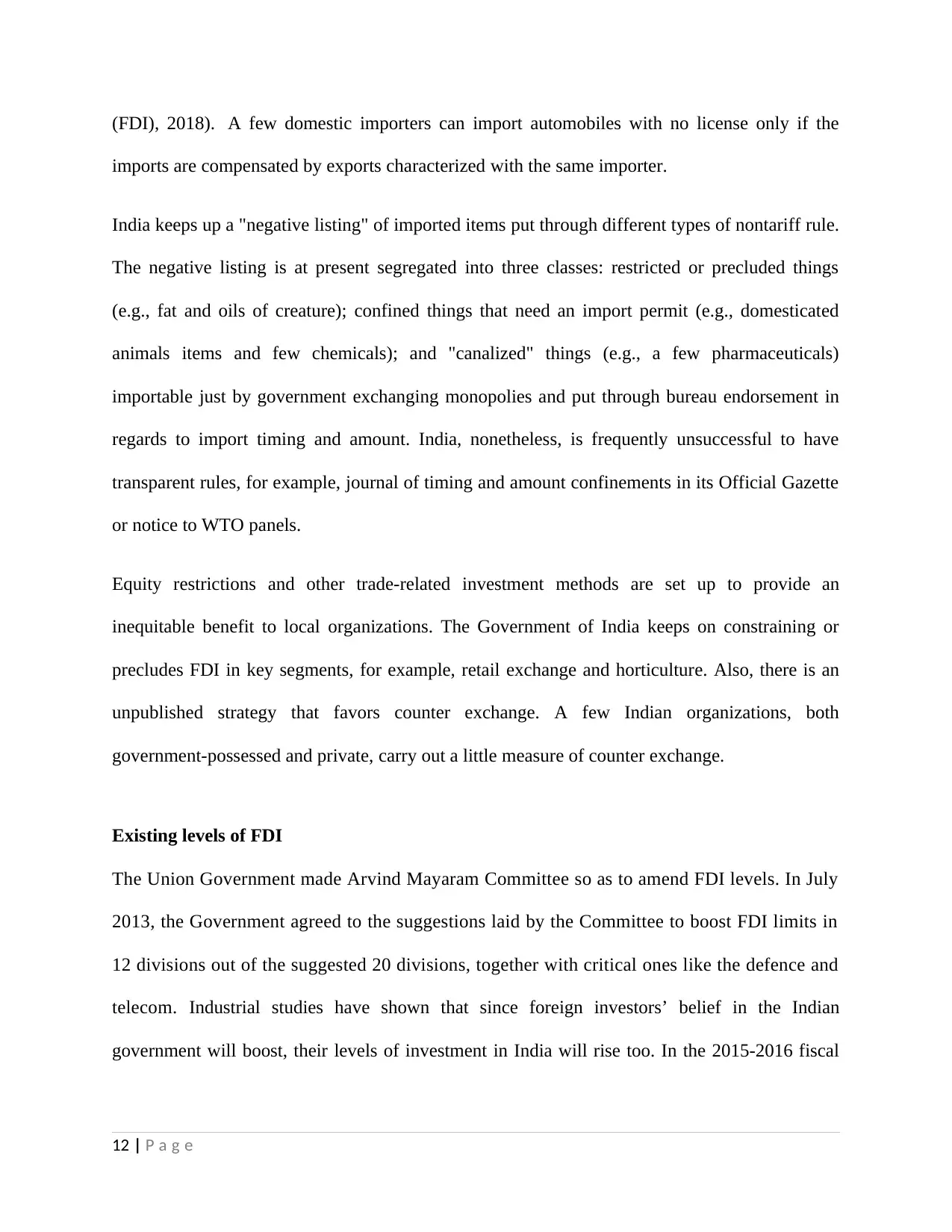
(FDI), 2018). A few domestic importers can import automobiles with no license only if the
imports are compensated by exports characterized with the same importer.
India keeps up a "negative listing" of imported items put through different types of nontariff rule.
The negative listing is at present segregated into three classes: restricted or precluded things
(e.g., fat and oils of creature); confined things that need an import permit (e.g., domesticated
animals items and few chemicals); and "canalized" things (e.g., a few pharmaceuticals)
importable just by government exchanging monopolies and put through bureau endorsement in
regards to import timing and amount. India, nonetheless, is frequently unsuccessful to have
transparent rules, for example, journal of timing and amount confinements in its Official Gazette
or notice to WTO panels.
Equity restrictions and other trade-related investment methods are set up to provide an
inequitable benefit to local organizations. The Government of India keeps on constraining or
precludes FDI in key segments, for example, retail exchange and horticulture. Also, there is an
unpublished strategy that favors counter exchange. A few Indian organizations, both
government-possessed and private, carry out a little measure of counter exchange.
Existing levels of FDI
The Union Government made Arvind Mayaram Committee so as to amend FDI levels. In July
2013, the Government agreed to the suggestions laid by the Committee to boost FDI limits in
12 divisions out of the suggested 20 divisions, together with critical ones like the defence and
telecom. Industrial studies have shown that since foreign investors’ belief in the Indian
government will boost, their levels of investment in India will rise too. In the 2015-2016 fiscal
12 | P a g e
imports are compensated by exports characterized with the same importer.
India keeps up a "negative listing" of imported items put through different types of nontariff rule.
The negative listing is at present segregated into three classes: restricted or precluded things
(e.g., fat and oils of creature); confined things that need an import permit (e.g., domesticated
animals items and few chemicals); and "canalized" things (e.g., a few pharmaceuticals)
importable just by government exchanging monopolies and put through bureau endorsement in
regards to import timing and amount. India, nonetheless, is frequently unsuccessful to have
transparent rules, for example, journal of timing and amount confinements in its Official Gazette
or notice to WTO panels.
Equity restrictions and other trade-related investment methods are set up to provide an
inequitable benefit to local organizations. The Government of India keeps on constraining or
precludes FDI in key segments, for example, retail exchange and horticulture. Also, there is an
unpublished strategy that favors counter exchange. A few Indian organizations, both
government-possessed and private, carry out a little measure of counter exchange.
Existing levels of FDI
The Union Government made Arvind Mayaram Committee so as to amend FDI levels. In July
2013, the Government agreed to the suggestions laid by the Committee to boost FDI limits in
12 divisions out of the suggested 20 divisions, together with critical ones like the defence and
telecom. Industrial studies have shown that since foreign investors’ belief in the Indian
government will boost, their levels of investment in India will rise too. In the 2015-2016 fiscal
12 | P a g e
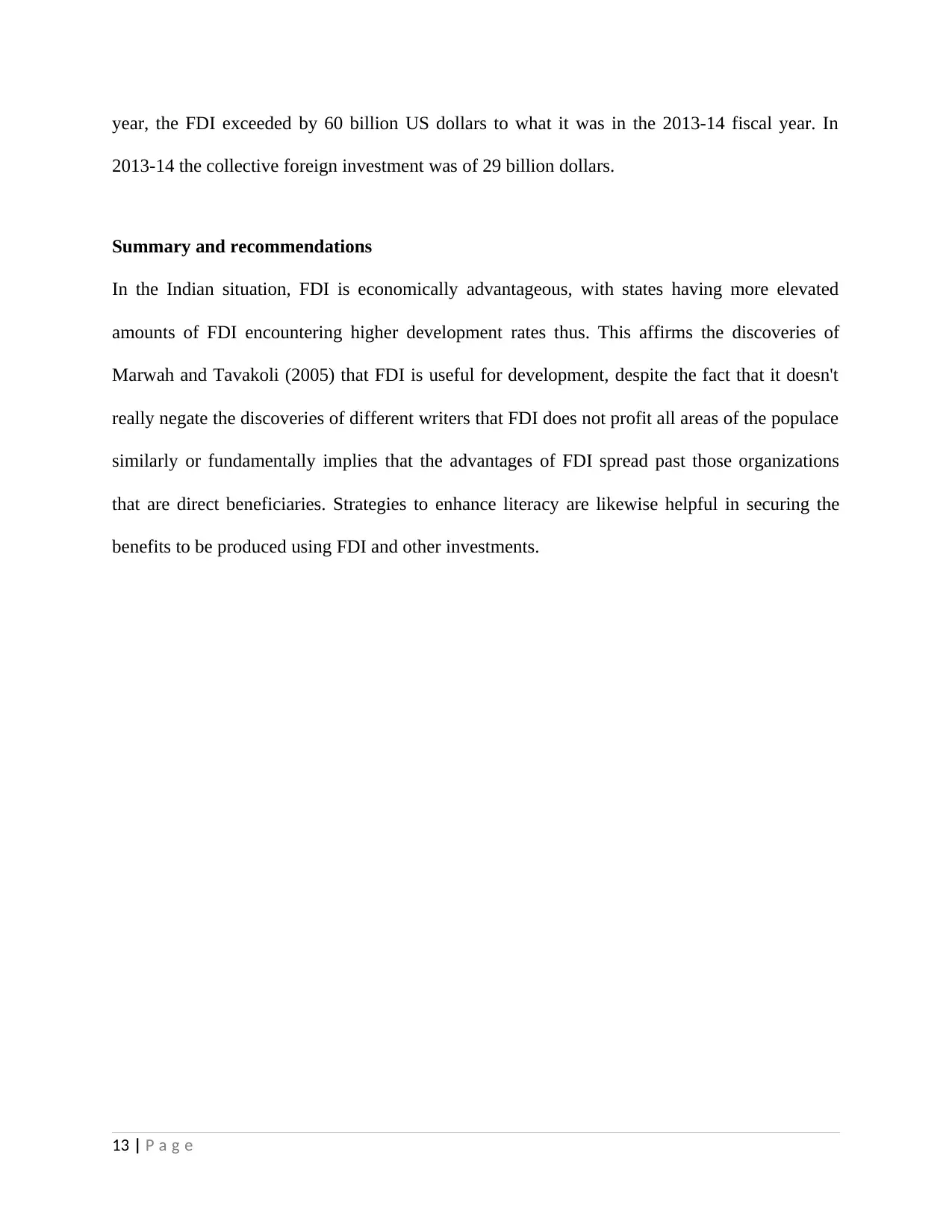
year, the FDI exceeded by 60 billion US dollars to what it was in the 2013-14 fiscal year. In
2013-14 the collective foreign investment was of 29 billion dollars.
Summary and recommendations
In the Indian situation, FDI is economically advantageous, with states having more elevated
amounts of FDI encountering higher development rates thus. This affirms the discoveries of
Marwah and Tavakoli (2005) that FDI is useful for development, despite the fact that it doesn't
really negate the discoveries of different writers that FDI does not profit all areas of the populace
similarly or fundamentally implies that the advantages of FDI spread past those organizations
that are direct beneficiaries. Strategies to enhance literacy are likewise helpful in securing the
benefits to be produced using FDI and other investments.
13 | P a g e
2013-14 the collective foreign investment was of 29 billion dollars.
Summary and recommendations
In the Indian situation, FDI is economically advantageous, with states having more elevated
amounts of FDI encountering higher development rates thus. This affirms the discoveries of
Marwah and Tavakoli (2005) that FDI is useful for development, despite the fact that it doesn't
really negate the discoveries of different writers that FDI does not profit all areas of the populace
similarly or fundamentally implies that the advantages of FDI spread past those organizations
that are direct beneficiaries. Strategies to enhance literacy are likewise helpful in securing the
benefits to be produced using FDI and other investments.
13 | P a g e
Paraphrase This Document
Need a fresh take? Get an instant paraphrase of this document with our AI Paraphraser
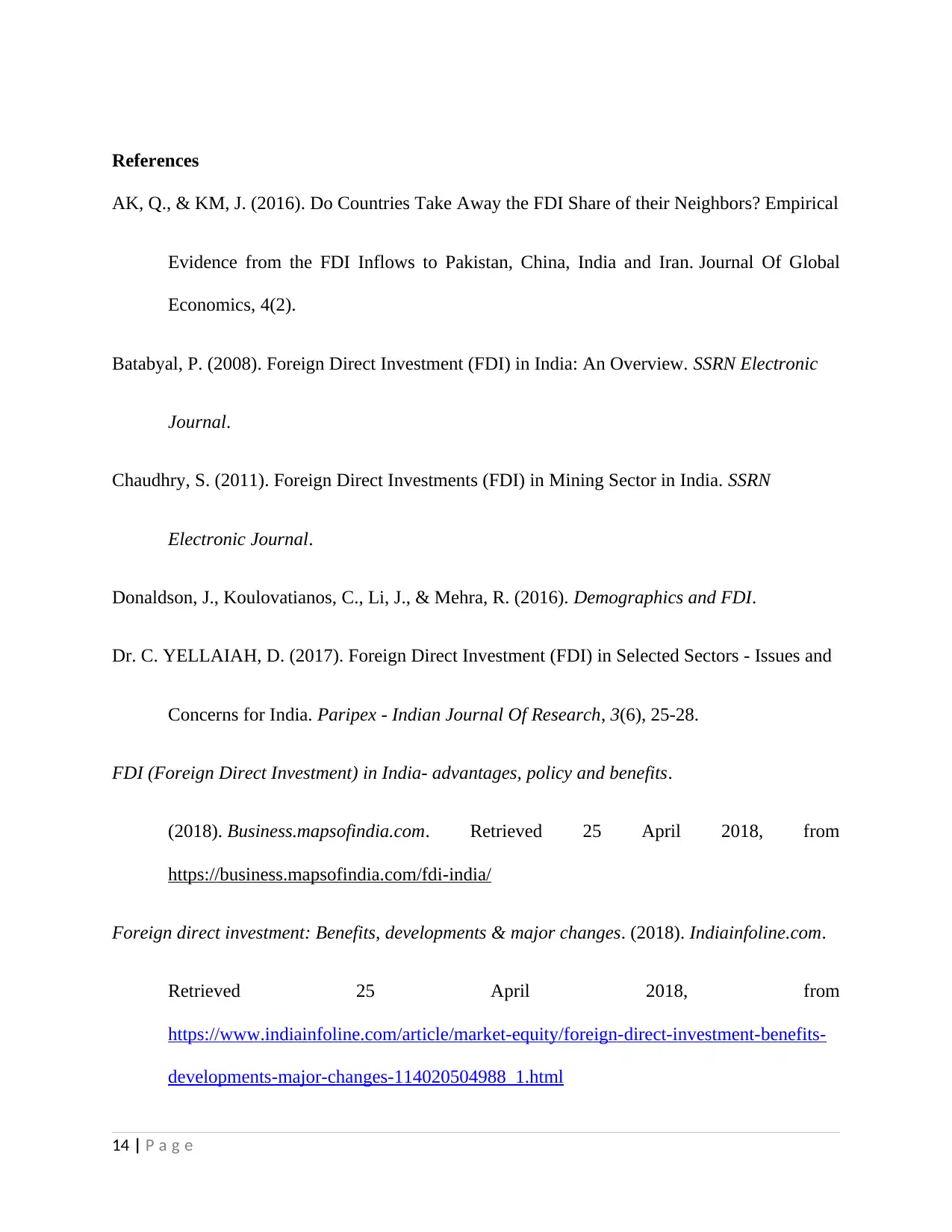
References
AK, Q., & KM, J. (2016). Do Countries Take Away the FDI Share of their Neighbors? Empirical
Evidence from the FDI Inflows to Pakistan, China, India and Iran. Journal Of Global
Economics, 4(2).
Batabyal, P. (2008). Foreign Direct Investment (FDI) in India: An Overview. SSRN Electronic
Journal.
Chaudhry, S. (2011). Foreign Direct Investments (FDI) in Mining Sector in India. SSRN
Electronic Journal.
Donaldson, J., Koulovatianos, C., Li, J., & Mehra, R. (2016). Demographics and FDI.
Dr. C. YELLAIAH, D. (2017). Foreign Direct Investment (FDI) in Selected Sectors - Issues and
Concerns for India. Paripex - Indian Journal Of Research, 3(6), 25-28.
FDI (Foreign Direct Investment) in India- advantages, policy and benefits.
(2018). Business.mapsofindia.com. Retrieved 25 April 2018, from
https://business.mapsofindia.com/fdi-india/
Foreign direct investment: Benefits, developments & major changes. (2018). Indiainfoline.com.
Retrieved 25 April 2018, from
https://www.indiainfoline.com/article/market-equity/foreign-direct-investment-benefits-
developments-major-changes-114020504988_1.html
14 | P a g e
AK, Q., & KM, J. (2016). Do Countries Take Away the FDI Share of their Neighbors? Empirical
Evidence from the FDI Inflows to Pakistan, China, India and Iran. Journal Of Global
Economics, 4(2).
Batabyal, P. (2008). Foreign Direct Investment (FDI) in India: An Overview. SSRN Electronic
Journal.
Chaudhry, S. (2011). Foreign Direct Investments (FDI) in Mining Sector in India. SSRN
Electronic Journal.
Donaldson, J., Koulovatianos, C., Li, J., & Mehra, R. (2016). Demographics and FDI.
Dr. C. YELLAIAH, D. (2017). Foreign Direct Investment (FDI) in Selected Sectors - Issues and
Concerns for India. Paripex - Indian Journal Of Research, 3(6), 25-28.
FDI (Foreign Direct Investment) in India- advantages, policy and benefits.
(2018). Business.mapsofindia.com. Retrieved 25 April 2018, from
https://business.mapsofindia.com/fdi-india/
Foreign direct investment: Benefits, developments & major changes. (2018). Indiainfoline.com.
Retrieved 25 April 2018, from
https://www.indiainfoline.com/article/market-equity/foreign-direct-investment-benefits-
developments-major-changes-114020504988_1.html
14 | P a g e
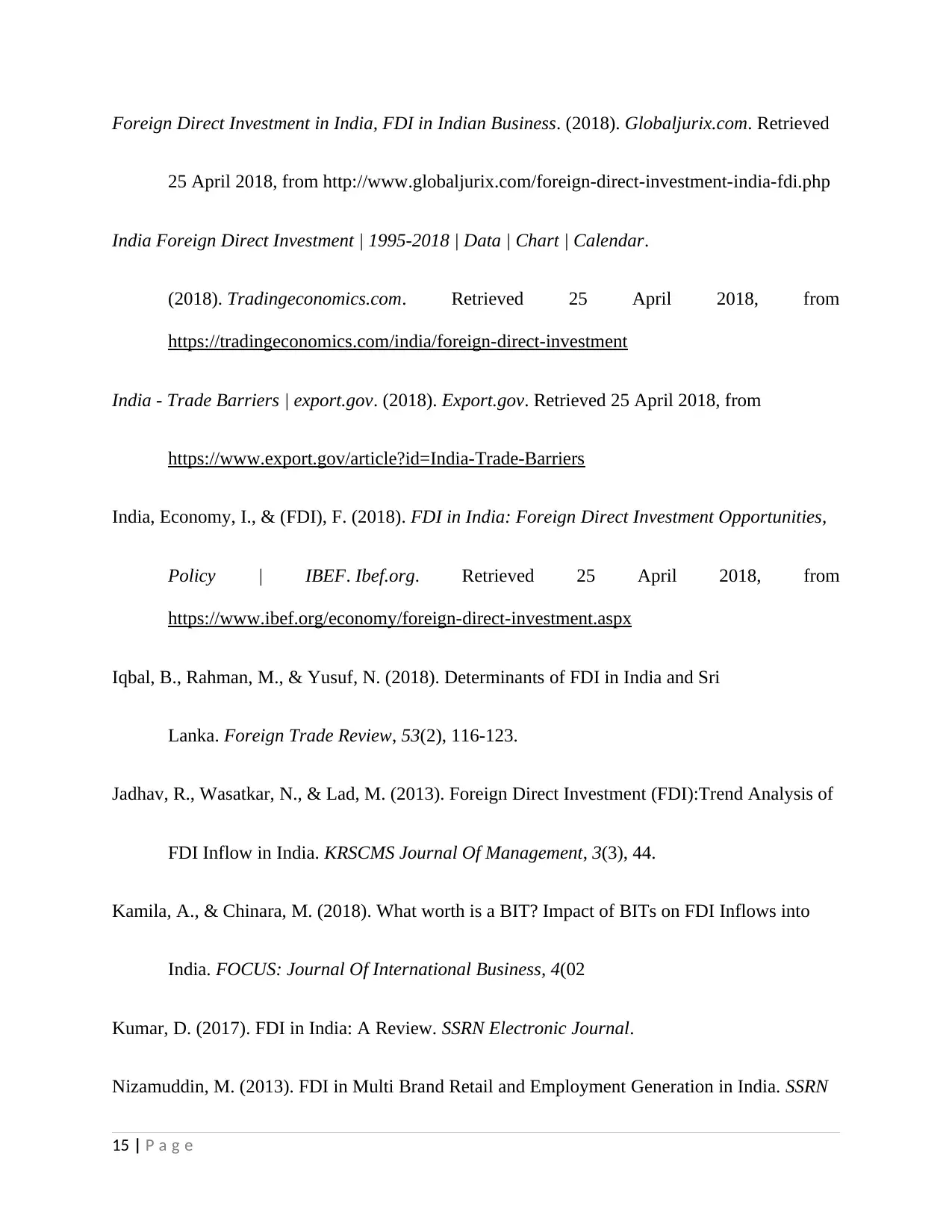
Foreign Direct Investment in India, FDI in Indian Business. (2018). Globaljurix.com. Retrieved
25 April 2018, from http://www.globaljurix.com/foreign-direct-investment-india-fdi.php
India Foreign Direct Investment | 1995-2018 | Data | Chart | Calendar.
(2018). Tradingeconomics.com. Retrieved 25 April 2018, from
https://tradingeconomics.com/india/foreign-direct-investment
India - Trade Barriers | export.gov. (2018). Export.gov. Retrieved 25 April 2018, from
https://www.export.gov/article?id=India-Trade-Barriers
India, Economy, I., & (FDI), F. (2018). FDI in India: Foreign Direct Investment Opportunities,
Policy | IBEF. Ibef.org. Retrieved 25 April 2018, from
https://www.ibef.org/economy/foreign-direct-investment.aspx
Iqbal, B., Rahman, M., & Yusuf, N. (2018). Determinants of FDI in India and Sri
Lanka. Foreign Trade Review, 53(2), 116-123.
Jadhav, R., Wasatkar, N., & Lad, M. (2013). Foreign Direct Investment (FDI):Trend Analysis of
FDI Inflow in India. KRSCMS Journal Of Management, 3(3), 44.
Kamila, A., & Chinara, M. (2018). What worth is a BIT? Impact of BITs on FDI Inflows into
India. FOCUS: Journal Of International Business, 4(02
Kumar, D. (2017). FDI in India: A Review. SSRN Electronic Journal.
Nizamuddin, M. (2013). FDI in Multi Brand Retail and Employment Generation in India. SSRN
15 | P a g e
25 April 2018, from http://www.globaljurix.com/foreign-direct-investment-india-fdi.php
India Foreign Direct Investment | 1995-2018 | Data | Chart | Calendar.
(2018). Tradingeconomics.com. Retrieved 25 April 2018, from
https://tradingeconomics.com/india/foreign-direct-investment
India - Trade Barriers | export.gov. (2018). Export.gov. Retrieved 25 April 2018, from
https://www.export.gov/article?id=India-Trade-Barriers
India, Economy, I., & (FDI), F. (2018). FDI in India: Foreign Direct Investment Opportunities,
Policy | IBEF. Ibef.org. Retrieved 25 April 2018, from
https://www.ibef.org/economy/foreign-direct-investment.aspx
Iqbal, B., Rahman, M., & Yusuf, N. (2018). Determinants of FDI in India and Sri
Lanka. Foreign Trade Review, 53(2), 116-123.
Jadhav, R., Wasatkar, N., & Lad, M. (2013). Foreign Direct Investment (FDI):Trend Analysis of
FDI Inflow in India. KRSCMS Journal Of Management, 3(3), 44.
Kamila, A., & Chinara, M. (2018). What worth is a BIT? Impact of BITs on FDI Inflows into
India. FOCUS: Journal Of International Business, 4(02
Kumar, D. (2017). FDI in India: A Review. SSRN Electronic Journal.
Nizamuddin, M. (2013). FDI in Multi Brand Retail and Employment Generation in India. SSRN
15 | P a g e
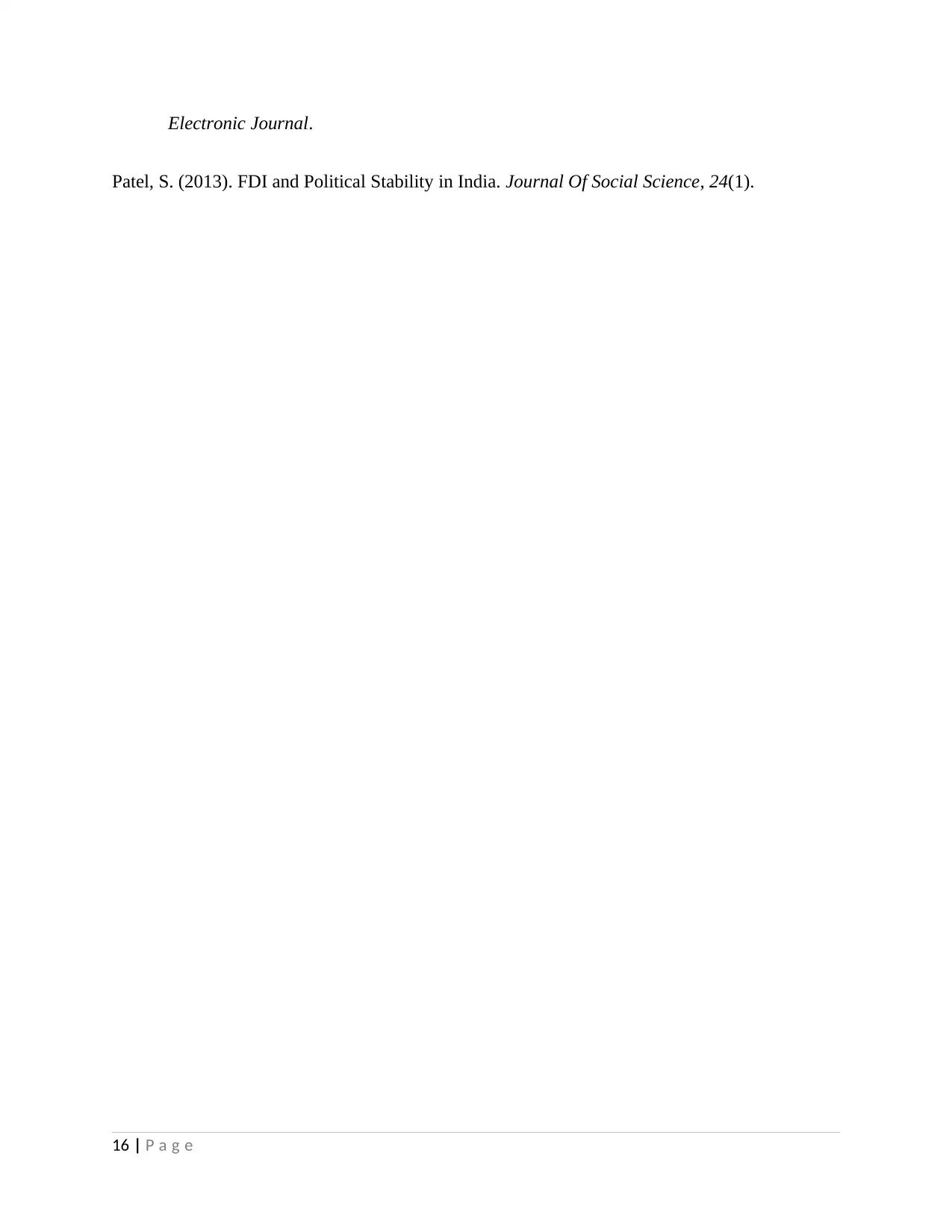
Electronic Journal.
Patel, S. (2013). FDI and Political Stability in India. Journal Of Social Science, 24(1).
16 | P a g e
Patel, S. (2013). FDI and Political Stability in India. Journal Of Social Science, 24(1).
16 | P a g e
1 out of 16
Related Documents
Your All-in-One AI-Powered Toolkit for Academic Success.
+13062052269
info@desklib.com
Available 24*7 on WhatsApp / Email
![[object Object]](/_next/static/media/star-bottom.7253800d.svg)
Unlock your academic potential
© 2024 | Zucol Services PVT LTD | All rights reserved.





